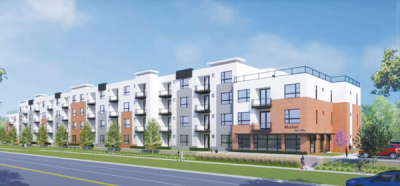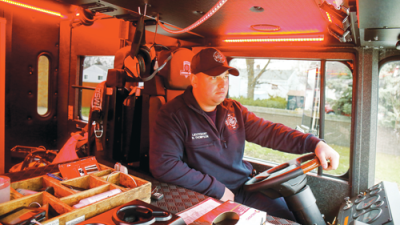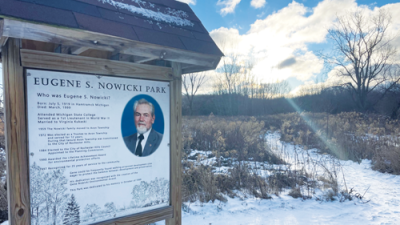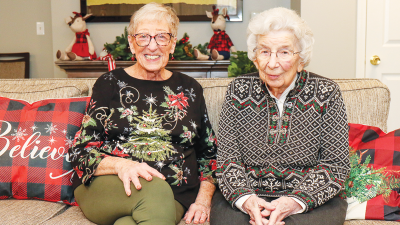
On Aug. 7, the Sterling Heights City Council voted 5-2 to pass the Chaldean Community Foundation’s second apartment complex proposal for the North Van Dyke Avenue Corridor, as seen in this concept rendering.
Image provided by Nowak & Fraus Engineers
STERLING HEIGHTS — The Sterling Heights City Council recently broke its July deadlock over whether to approve the Chaldean Community Foundation’s second apartment complex proposal in the North Van Dyke Avenue corridor.
On Aug. 7, the council voted 5-2 to approve the plan for a four-story complex at 43934 Van Dyke Ave.
Mayor Michael Taylor, Mayor Pro Tem Liz Sierawski, and council members Barbara Ziarko, Michael Radtke and Henry Yanez voted yes, while councilwomen Deanna Koski and Maria Schmidt voted against it.
That vote followed a 3-3 tie during the July 16 council meeting, in which Yanez was absent and Sierawski voted no.
Under the development deal, the city will sell the developer — CCF Development Grillo Limited Dividend Housing Association LLC — approximately 2 acres of land for around $30,000 an acre. The city says it paid around $640,000 for the overall site’s 10-plus acres using American Rescue Plan Act funds.
During the development process, the developer will temporarily assume liability for the site’s 10-plus acres. But then the developer will have to give the city back the rest of the land it wasn’t using, which the city hopes to use as green space or for recreation.
According to CCF President Martin Manna, this apartment complex proposal is an estimated $30 million project, which will be made possible in part through a loan from the Michigan State Housing Development Authority.
The complex is expected to contain 82 one- or two-bedroom units, and also some retail space. Manna said there is interest in putting a bakery, coffee or dessert shop there, or perhaps a pharmacy or an urgent care.
During the Aug. 7 meeting, residents made comments for around an hour and a half, with most opposing the plan. Critics aired comments largely similar to the prior meeting, such as worries over traffic issues; concerns over the development’s proximity to the Clinton River and its floodplain; and fears over the development possibly making local flooding worse.
Dave Bilan, who said he is a recent arrival to Sterling Heights, talked about the importance of risk mitigation and risk aversion.
“If you know something is going to happen at some point, you basically want to avoid investing or building in that area,” Bilan said. “The engineer talked about the problem isn’t the rain; it’s the runoff. That’s kind of like saying, it’s not the fall that kills you — it’s the sudden stop.”
Earlier in the meeting, James Burton, from engineering firm Hubbell, Roth & Clark, gave a presentation on the floodplain and told the council that, “in our opinion and review of all the materials so far to date, I don’t see how CCF is creating any additional impacts.”
The public commenters who spoke in favor of the plan said the development could bring affordable housing to the city; could help develop the area into a place more accessible for pedestrians or bicyclists; or could serve as an good example of the CCF’s work in the community.
When council members spoke, Yanez said he has walked the site and talked to experts, including the city engineer; a clean water expert; a construction superintendent; and a representative from the Michigan Department of Environment, Great Lakes, and Energy.
Yanez also said the pushback against the proposal caught him off guard.
“This area of town, folks, needs a shot in the arm,” he said.
Sierawski explained her vote change, adding that she has also talked to experts, including from EGLE, since the prior meeting. She said talking to her civil engineer brother and EGLE helped convince her that this plan will neither hurt the land nor do damage. She said she understands the willingness to sell the land for less than its original purchase price because it’s a way for the city to start securing a return on investment via development-produced tax revenue.
“You’re going to get your tax money for that,” Sierawski said. “It’s like getting rent back. … You’re going to constantly get money back. So it’s not a bad investment. It’s not negating our fiduciary responsibilities.”
Learn more about Sterling Heights by visiting sterlingheights.gov or by calling (586) 446-2489. To find out more about the Chaldean Community Foundation, visit chaldeanfoundation.org.
 Publication select ▼
Publication select ▼














